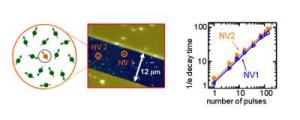Sep 18 2010
Finding ways to control matter at the level of single atoms and electrons fascinates many scientists and engineers because the ability to manipulate single charges and single magnetic moments (spins) may help researchers penetrate deep into the mysteries of quantum mechanics and modern solid-state physics.
It may also allow development of new, highly sensitive magnetometers with nanometer resolution, single-spin transistors for coherent spintronics, and solid-state devices for quantum information processing.
 Spins of nitrogen-vacancy centers in diamond (represented on the center photo as bright spots and denoted as the orange arrow on the figure to the left) interact with a bath of environmental spins (denoted as green arrows). The environmental spins interact with the N-V spins, and destroy their fragile quantum state.
Spins of nitrogen-vacancy centers in diamond (represented on the center photo as bright spots and denoted as the orange arrow on the figure to the left) interact with a bath of environmental spins (denoted as green arrows). The environmental spins interact with the N-V spins, and destroy their fragile quantum state.
Recently, a collaboration of experimentalists from the Kavli Institute of Nanosciences at Delft University of Technology and theorists at the U.S. Department of Energy's Ames Laboratory made a breakthrough in the area of controlling single quantum spins.
The researchers developed and implemented a special kind of quantum control over a single quantum magnetic moment (spin) of an atomic-sized impurity in diamond. These impurities, called nitrogen-vacancy (or N-V) centers, have attracted much attention due to their unusual magnetic and optical properties. But their fragile quantum states are easily destroyed by even miniscule interactions with the outside world.
By applying a specially designed sequence of high-precision electromagnetic pulses, the scientists were able to protect the arbitrary quantum state of a single spin, and they made the spin evolve as if it was completely decoupled from the outside world. In this way, scientists achieved a 25-fold increase in the lifetime of the quantum spin state at room temperature. This is the first demonstration of a universal dynamical decoupling realized on a single solid state quantum spin.
"Uncontrolled interactions of the spins with the environment have been the major hurdle for implementing quantum technologies" said the leader of Dutch experimental group, associate professor Ronald Hanson from Kavli Institute of Nanoscience at Delft. "Our results demonstrate that this hurdle can be overcome by advanced control of the spin itself."
"Implementing dynamical decoupling on a single quantum spin in solid state at room temperature has been an appealing but distant goal for quite a while. In the meantime, much theoretical and experimental knowledge has been accumulated in the community," added Viatcheslav Dobrovitski, who led the theoretical research effort at the Ames Laboratory. "We used this knowledge to design our pulse sequences, and the collaboration between theory and experiment greatly helped us in this work."
Besides its importance to fundamental understanding of quantum mechanics, the team's achievement opens a way to using the impurity centers in diamond as highly sensitive nanoscale magnetic sensors, and potentially, as qubits for larger-scale quantum information processing.
Source: http://www.external.ameslab.gov/